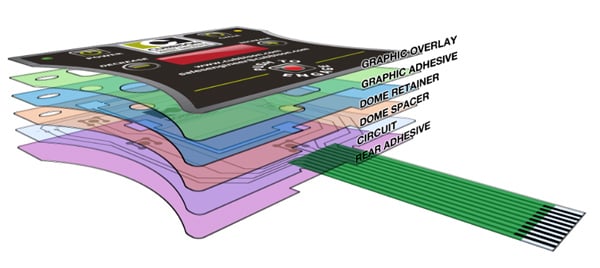Membrane Change Innovation: The Secret to Dependable and Affordable User Interfaces
Membrane button modern technology has actually arised as a critical component in the layout of customer interfaces, supplying both dependability and cost-effectiveness throughout a diverse range of applications. As we check out the multifaceted benefits of membrane layer switches, their potential for advancement raises inquiries about future applications and progressing patterns.
Understanding Membrane Switch Over Innovation
Membrane layer switch technology is an extensively used user interface service in numerous electronic tools, using a smooth blend of capability and design. This innovation includes multiple layers of products, usually including a graphic overlay, spacer layer, and a circuit layer. The visuals overlay presents the interface aspects, while the spacer layer divides the circuit layer from the overlay up until a user turns on a switch.
When stress is related to the overlay, the circuit layer completes the electric circuit, sending a signal to the tool. This mechanism enables numerous arrangements, including tactile responses and backlighting options, enhancing individual communication. Membrane layer buttons are generally made making use of durable materials such as polyester or polycarbonate, making certain long life and resistance to environmental variables like moisture and dust.
The flexibility of membrane switches allows their application in varied sectors, consisting of clinical devices, customer electronic devices, and commercial controls. Their small style enables assimilation right into space-constrained environments, offering an effective individual interface without jeopardizing aesthetic charm. Comprehending the intricacies of membrane switch technology is important for producers and developers looking for to create trustworthy and reliable human-machine user interfaces.
Secret Benefits of Membrane Switches
While various interface solutions exist, membrane layer switches over deal unique benefits that make them a preferred selection in countless applications. Among the main benefits is their resilience; membrane layer buttons are created to stand up to extreme environmental conditions, consisting of wetness, dirt, and temperature variations, guaranteeing lasting efficiency. This strength significantly lowers the demand for regular substitutes, consequently lowering overall upkeep costs.

Furthermore, membrane layer switches are lightweight and portable, making them ideal for applications where area is limited. Their low-profile layout adds to a smooth look without jeopardizing functionality.
Cost-effectiveness is additionally a noteworthy advantage, as the production procedure for membrane layer changes often tends to be less costly contrasted to standard mechanical switches. This affordability, incorporated with their integrity and convenience of installment, positions membrane layer switches as a useful service for a wide range of sectors looking for efficient and effective interface.
Applications Across Various Industries
How do membrane switches adjust to the diverse needs of various industries? Membrane button technology is significantly acknowledged for its convenience, making it appropriate for a wide array of applications throughout multiple sectors.
In customer electronic devices, membrane layer buttons give a small look at this site option for push-button controls and home devices, boosting individual experience with user-friendly style. Furthermore, the commercial field leverages membrane switches for equipment control board, profiting from their resistance to severe settings, such as dampness and dirt.
Army and aerospace applications likewise utilize membrane switches for their dependability and capability to hold up see this website against severe conditions, making sure operational performance in essential scenarios. Furthermore, the food and beverage industry takes on these buttons for automated systems, where sanitation and convenience of operation are paramount. Eventually, membrane buttons are tailored to meet the special demands of each sector, showing their crucial function in modern-day innovation user interfaces
Design and Customization Choices

In the realm of membrane layer button innovation, style and customization options play a crucial role in improving performance and customer interaction. These switches can be tailored to meet particular functional demands and aesthetic preferences, making them functional elements in numerous applications.
Among the key modification options is the layout of the button itself, which can be created to fit distinct user interfaces and ergonomic factors to consider. By adjusting the form, size, and setup of buttons, suppliers can produce intuitive layouts that promote convenience of use. Additionally, the incorporation of various colors and graphic overlays permits branding and enhanced visibility, making sure that individuals can swiftly identify functions.
Furthermore, membrane switches can be engineered with different responsive responses devices, such as increased switches or distinct clicks, to improve the user experience. Different materials can additionally be picked for sturdiness and environmental resistance, dealing with elements such as moisture, temperature level fluctuations, and chemical my link exposure.
Inevitably, the extensive style and customization alternatives available in membrane layer switch modern technology empower services to develop tailored solutions that not only fulfill practical requirements however additionally line up with their branding and operational needs.

Future Patterns in Membrane Layer Switches
As membrane layer button technology remains to evolve, future trends are increasingly concentrated on enhancing user experience and incorporating advanced functionalities. One significant trend is the integration of touch-sensitive and capacitive innovations into conventional membrane layer switches. This development permits more intuitive customer interfaces, giving responsive responses while keeping a smooth layout.
One more arising fad is using environmentally friendly materials, driven by the growing demand for lasting manufacturing practices. Suppliers are seeking to reduce their carbon impact by utilizing recyclable substratums and low-impact inks, straightening with global sustainability goals.
Moreover, the rise of the Internet of Things (IoT) is triggering the incorporation of wise features right into membrane layer buttons. Boosted connection alternatives will certainly enable tools to interact with each various other, allowing for smooth assimilation into broader systems.
In addition, innovations in printing innovations, such as electronic printing, are allowing for better design versatility and modification. This makes it possible for producers to create intricate designs and vibrant colors cost-effectively.

Conclusion
In final thought, membrane layer button modern technology stands for an important technology in individual interface layout, offering considerable benefits in sturdiness, customization, and cost-effectiveness. As innovations proceed to emerge, especially in touch-sensitive interfaces and sustainable products, the potential for membrane changes to boost customer experience and functionality remains appealing.